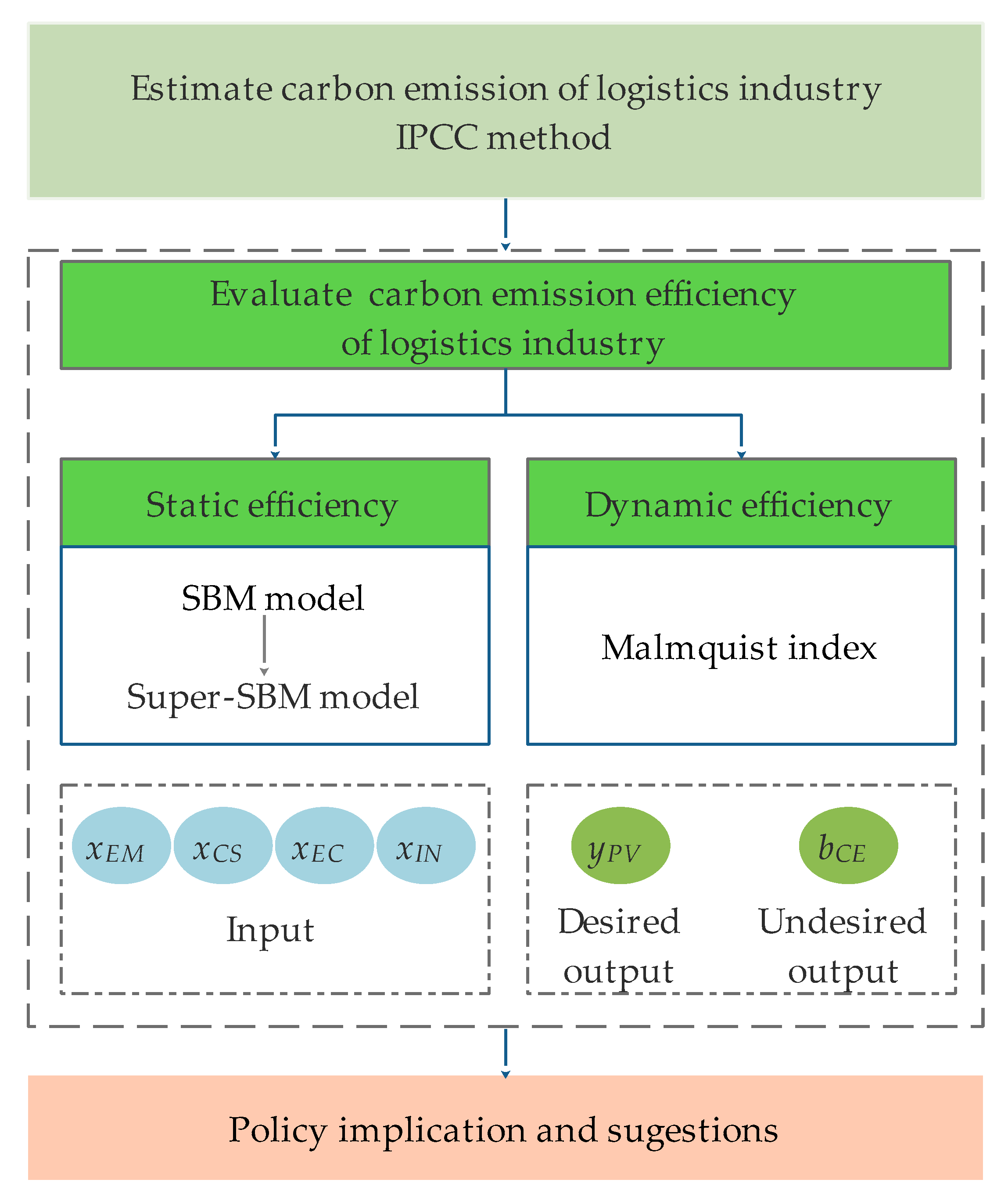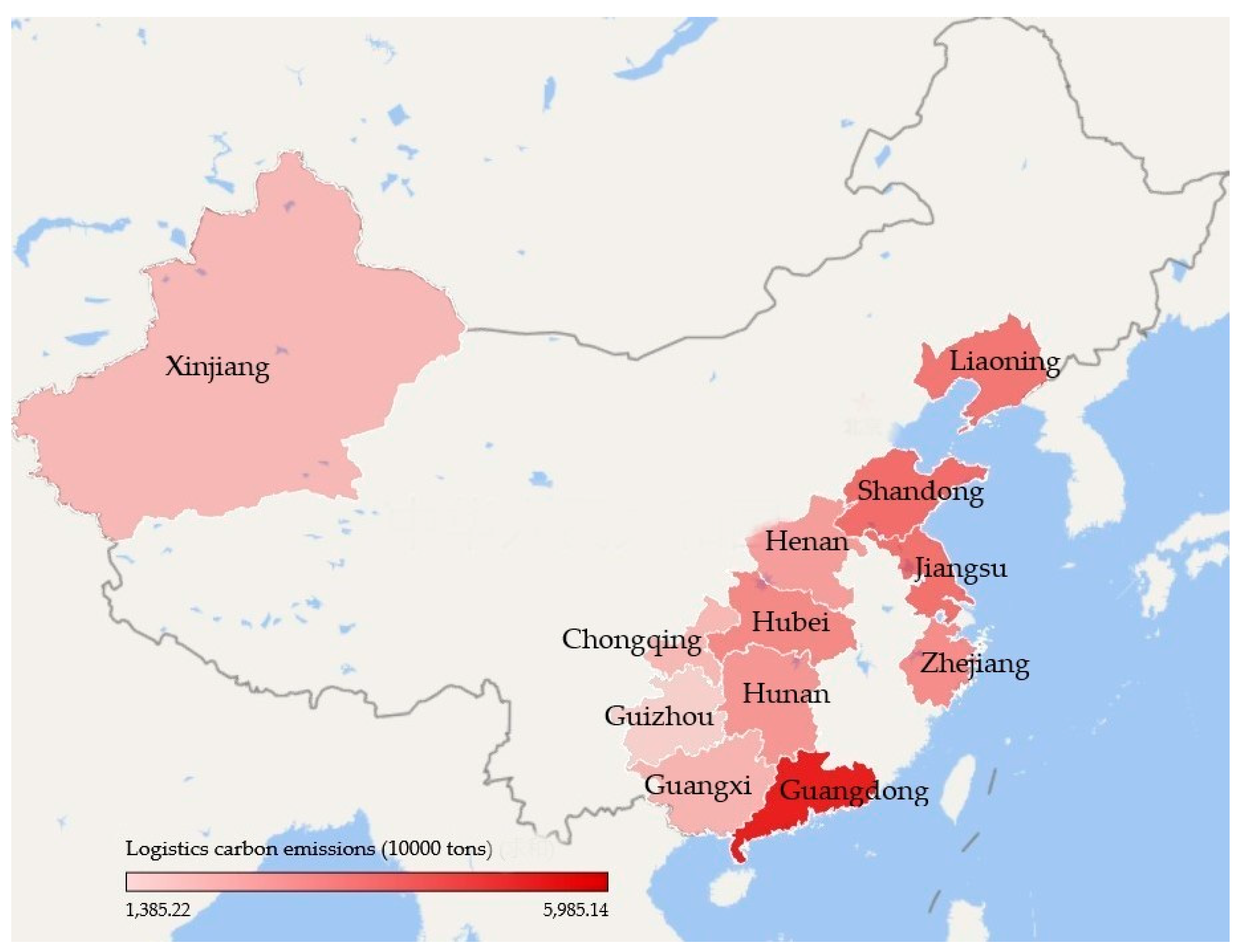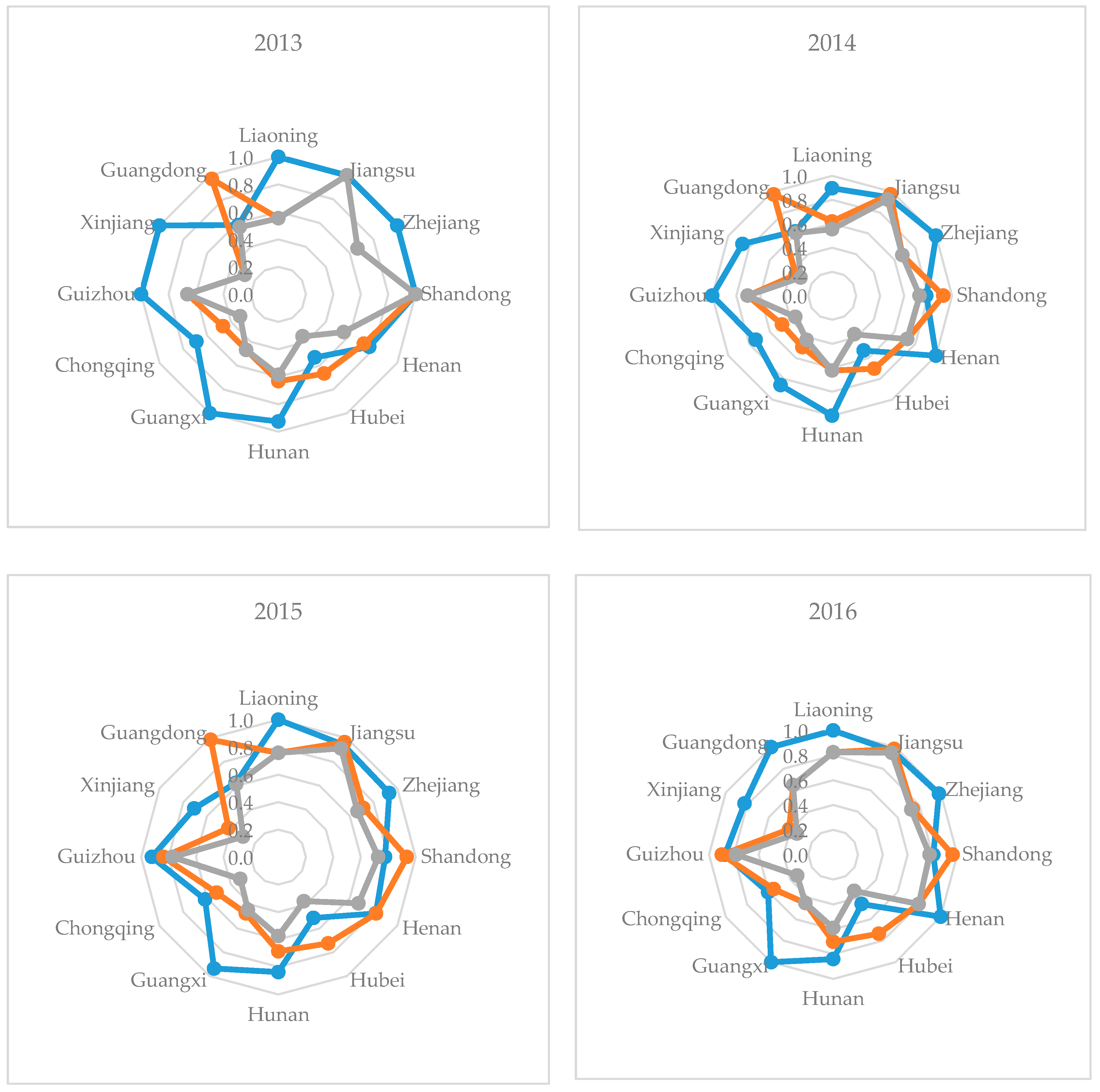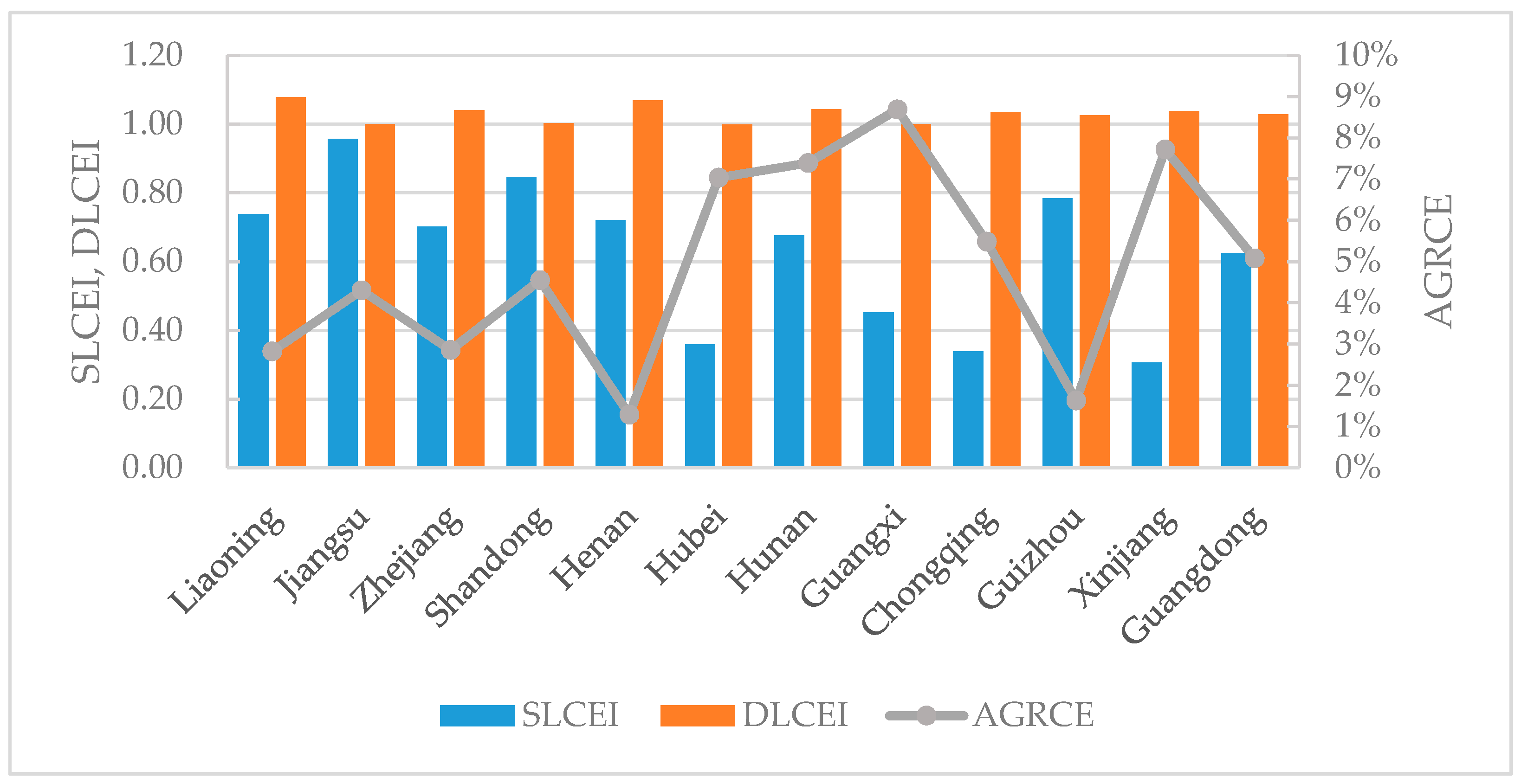Evaluating the Carbon Emissions Efficiency of the Logistics Industry Based on a Super-SBM Model and the Malmquist Index from a Strong Transportation Strategy Perspective in China
Abstract
1. Introduction
2. Methodology
2.1. Carbon Emissions Estimation
2.2. Data Envelopment Analysis Method
2.2.1. Slack-Based Measurement Model
2.2.2. Super-Efficiency Slack-Based Measurement Model
2.3. Malmquist Index
2.4. Variables and Data Description
3. Results and Discussions
3.1. Carbon Emissions of the Logistics Industry
3.2. Carbon Emissions Efficiency of the Logistics Industry
3.2.1. Static Carbon Emissions Efficiency of the Logistics Industry
3.2.2. Dynamic Carbon Emissions Efficiency of the Logistics Industry
3.3. Discussions
3.4. Policy Implication
4. Conclusions
Author Contributions
Funding
Acknowledgments
Conflicts of Interest
References
- CAIT Historical GHG Emissions. Available online: http://cait.wri.org (accessed on 20 March 2020).
- Mi, Z.; Meng, J.; Guan, D.; Shan, Y.; Song, M.; Wei, Y.M.; Liu, Z.; Hubacek, K. Chinese CO2 emission flows have reversed since the global financial crisis. Nat. Commun. 2017, 8, 1712. [Google Scholar] [CrossRef] [PubMed]
- IEA Oil Products Final Consumption by Sector. Available online: https://iea.blob.core.windows.net/assets/fffa1b7d-b0c5-4e64-86aa-5c9421832d73/WORLDBAL_Documentation.pdf (accessed on 2 April 2020).
- Yang, J.; Tang, L.; Mi, Z.; Liu, S.; Li, L.; Zheng, J. Carbon emissions performance in logistics at the city level. J. Clean Prod. 2019, 231, 1258–1266. [Google Scholar] [CrossRef]
- Geroliminis, N.; Carlos, F. A Review of Green Logistics Schemes Used in Cities around the World. Available online: http://escholarship.org/uc/item/4x89p485 (accessed on 20 March 2020).
- Liu, J.; Yuan, C.; Hafeez, M.; Yuan, Q. The relationship between environment and logistics performance: Evidence from Asian countries. J. Clean Prod. 2018, 204, 282–291. [Google Scholar] [CrossRef]
- IPCC. 2019 Refinement to the 2006 IPCC Guidelines for National Greenhouse Gas. Inventories; IPCC: Geneva, Switzerland, 2019. [Google Scholar]
- Bi, J.; Zhang, R.; Wang, H.; Liu, M.; Wu, Y. The benchmarks of carbon emissions and policy implications for China’s cities: Case of Nanjing. Energy Policy 2011, 39, 4785–4794. [Google Scholar] [CrossRef]
- SCOPRC. The outline of the 13th Five-Year Plan (2016–2020) for national economic and social Development of the People’s Republic of China. Available online: http://www.12371.cn/special/sswgh/ (accessed on 20 March 2020).
- CCCPC; SCOPRC. The CPC Central Committee and the State Council issued the Outline for Building a Strong Transport Country. Available online: http://www.gov.cn/zhengce/2019-09/19/content_5431432.htm (accessed on 20 December 2019).
- Wang, Z.; He, W. CO2 emissions efficiency and marginal abatement costs of the regional transportation sectors in China. Transp. Res. Part D Transport. Environ. 2017, 50, 83–97. [Google Scholar] [CrossRef]
- Karaman, A.S.; Kilic, M.; Uyar, A. Green logistics performance and sustainability reporting practices of the logistics sector: The moderating effect of corporate governance. J. Clean Prod. 2020, 258, 120718. [Google Scholar] [CrossRef]
- Ren, R.; Hu, W.; Dong, J.; Sun, B.; Chen, Y.; Chen, Z. A Systematic Literature Review of Green and Sustainable Logistics: Bibliometric Analysis, Research Trend and Knowledge Taxonomy. Int. J. Environ. Res. Public Health 2020, 17, 261. [Google Scholar] [CrossRef]
- Gang, T.; Li-cheng, S.; Fa-xin, C.; Ben-hai, G. Efficiency of energy-saving & emission-reducing and the affect factors on logistics industry. Ind. Eng. Manag. 2015, 20, 14–20. [Google Scholar]
- Lu, M.; Xie, R.; Chen, P.; Zou, Y.; Tang, J. Green Transportation and Logistics Performance: An Improved Composite Index. Sustainability 2019, 11, 2976. [Google Scholar] [CrossRef]
- Yang, X.; Ma, S.; Lu, Y. Evaluation of Logistics Efficiency under Carbon Emission Constraints: Taking the Ten Provinces and Cities as an Example with the Background of the “The Belt and Road”. Ecol. Econ. 2019, 35, 66–71. [Google Scholar]
- Zhang, L.; Li, D.; Gong, A. Dynamic changes in total factor energy efficiency and regional disparity in the logistics sector in China. Resour. Sci. 2015, 37, 754–763. [Google Scholar]
- Hui, L.; Wei, L. Carbon emission efficiency evaluation and dynamic evolution analysis of logistics industry: Taking the provinces along the Silk Road Economic Belt as an example. Environ. Sci. Technol. 2019, 42, 165–171. [Google Scholar]
- Cook, W.D.; Seiford, L.M. Data envelopment analysis (DEA)—Thirty years on. Eur. J. Oper. Res. 2009, 192, 1–17. [Google Scholar] [CrossRef]
- Tone, K. A slacks-based measure of efficiency in data envelopment analysis. Eur. J. Oper. Res. 2001, 130, 498–509. [Google Scholar] [CrossRef]
- Chang, Y.; Zhang, N.; Danao, D.; Zhang, N. Environmental efficiency analysis of transportation system in China: A non-radial DEA approach. Energy Policy 2013, 58, 277–283. [Google Scholar] [CrossRef]
- Tang, T.; You, J.; Sun, H.; Zhang, H. Transportation Efficiency Evaluation Considering the Environmental Impact for China’s Freight Sector: A Parallel Data Envelopment Analysis. Sustainability 2019, 11, 5108. [Google Scholar] [CrossRef]
- Mariano, E.B.; Gobbo, J.A.; de Castro Camioto, F. CO2 emissions and logistics performance: A composite index proposal. J. Clean Prod. 2017, 163, 166–178. [Google Scholar] [CrossRef]
- Tone, K. A slacks-based measure of super-efficiency in data envelopment analysis. Eur. J. Oper. Res. 2002, 143, 32–41. [Google Scholar] [CrossRef]
- Li, H.; Shi, J. Energy efficiency analysis on Chinese industrial sectors: An improved Super-SBM model with undesirable outputs. J. Clean Prod. 2014, 65, 97–107. [Google Scholar] [CrossRef]
- Zhang, J.; Zeng, W.; Wang, J.; Yang, F.; Jiang, H. Regional low-carbon economy efficiency in China: Analysis based on the Super-SBM model with CO2 emissions. J. Clean Prod. 2015, 163, 202–211. [Google Scholar] [CrossRef]
- Zhou, L.; Zhu, S. Research on the Efficiency of Chinese Commercial Banks Based on Undesirable Output and Super-SBM DEA Model. J. Math. Financ. 2017, 7, 102–120. [Google Scholar] [CrossRef]
- Baixue, W.; Kun, G. The efficient of carbon emissions efficiency of Beijing public transportation system: Based on Super-efficicency SBM model using Malmquist-Luenberger Index. J. Syst. Sci. Math. Sci. 2018, 38, 456–467. [Google Scholar]
- Guoli, O.; Chang’Ran, X. Analysis of freight transport carbon emission efficiency in Beijing-Tianjin-Hebei: A study based on Super-efficiency SBM model and ML Index. J. Beijing Jiaotong Univ. (Soc. Sci. Ed.) 2020, 19, 48–57. [Google Scholar]
- Wang, C.; Day, J.; Lien, N.T.K.; Chien, L.Q. Integrating the Additive Seasonal Model and Super-SBM Model to Compute the Efficiency of Port Logistics Companies in Vietnam. Sustainability 2018, 10, 2782. [Google Scholar] [CrossRef]
- Long, R.; Ouyang, H.; Guo, H. Super-slack-based measuring data envelopment analysis on the spatial-temporal patterns of logistics ecological efficiency using global Malmquist Index model. Environ. Technol. Innov. 2020, 18, 100770. [Google Scholar] [CrossRef]
- IPCC. Guidelines for National Greenhouse Gas Inventories. Intergovernmental Panel on Climate Change. Available online: https://www.ipcc-nggip.iges.or.jp/public/2006gl/index.html (accessed on 6 March 2020).
- Li, W.; Bao, L.; Wang, L.; Li, Y.; Mai, X. Comparative evaluation of global low-carbon urban transport. Technol. Forecast. Soc. 2019, 143, 14–26. [Google Scholar] [CrossRef]
- Yu, W.; Wang, T.; Xiao, Y.; Chen, J.; Yan, X. A Carbon Emission Measurement Method for Individual Travel Based on Transportation Big Data: The Case of Nanjing Metro. Int J. Environ. Res. Public Health 2020, 17, 5957. [Google Scholar] [CrossRef] [PubMed]
- China, Q.A.S. China Quality and Standards Guidance GB/T 2589 “General Principles of Comprehensive Energy Consumption Calculation” revised national standard passed the review. China Qual. Stand. Herald 2019, 7, 9. [Google Scholar]
- Deng, Y.; Yan, Y. Evaluating Route and Frequency Design of Bus Lines Based on Data Envelopment Analysis with Network Epsilon-Based Measures. J. Adv. Transport. 2019, 2019, 5024253. [Google Scholar] [CrossRef]
- Fare, R.; Grosskopf, S.; Norris, M.; Zhang, Z.Z. Productivity Growth, Technical Progress, and Efficiency Change in Industrialized Countries. Am. Econ. Rev. 1994, 84, 66–83. [Google Scholar]
- Martins, V.W.B.; Anholon, R.; Quelhas, O.L.G.; Leal Filho, W. Sustainable Practices in Logistics Systems: An Overview of Companies in Brazil. Sustainability 2019, 11, 4140. [Google Scholar] [CrossRef]
- Guo, M.; Meng, J. Exploring the driving factors of carbon dioxide emission from transport sector in Beijing-Tianjin-Hebei region. J. Clean Prod. 2019, 226, 692–705. [Google Scholar] [CrossRef]
- Bai, C.; Chen, Y.; Yi, X.; Feng, C. Decoupling and decomposition analysis of transportation carbon emissions at the provincial level in China: Perspective from the 11th and 12th Five-Year Plan periods. Environ. Sci. Pollut. R 2019, 26, 15039–15056. [Google Scholar] [CrossRef] [PubMed]
- Wang, Y.; Zhou, Y.; Zhu, L.; Zhang, F.; Zhang, Y. Influencing Factors and Decoupling Elasticity of China’s Transportation Carbon Emissions. Energies 2018, 11, 1157. [Google Scholar] [CrossRef]
- Xie, R.; Fang, J.; Liu, C. The effects of transportation infrastructure on urban carbon emissions. Appl. Energy 2017, 196, 199–207. [Google Scholar] [CrossRef]
- Li, W.; Li, H.; Zhang, H.; Sun, S. The Analysis of CO2 Emissions and Reduction Potential in China’s Transport Sector. Math. Probl. Eng. 2016, 2016, 1043717. [Google Scholar]
- Quan, C.; Cheng, X.; Yu, S.; Ye, X. Analysis on the influencing factors of carbon emission in China’s logistics industry based on LMDI method. Sci. Total Environ. 2020, 734, 138473. [Google Scholar] [CrossRef]
- Tong, X.; Li, X.; Tong, L.; Jiang, X. Spatial Spillover and the Influencing Factors Relating to Provincial Carbon Emissions in China Based on the Spatial Panel Data Model. Sustainability 2018, 10, 4739. [Google Scholar] [CrossRef]
- Chen, W.; Yang, R. Evolving Temporal–Spatial Trends, Spatial Association, and Influencing Factors of Carbon Emissions in Mainland China: Empirical Analysis Based on Provincial Panel Data from 2006 to 2015. Sustainability 2018, 10, 2809. [Google Scholar] [CrossRef]







| Energy Type | NCV (kJ/kg) | CEF (kg/GJ) | COF (kg/TJ) | CO2 Emissions Factor (kgCO2/kg) |
|---|---|---|---|---|
| Raw coal | 20,908 | 26.37 | 0.94 | 1.9003 |
| Petrol | 43,070 | 18.9 | 0.98 | 2.9251 |
| Kerosene | 43,070 | 19.5 | 0.98 | 3.0179 |
| Diesel | 42,652 | 20.2 | 0.98 | 3.0959 |
| Fuel oil | 41,816 | 21.1 | 0.98 | 3.1705 |
| Coke | 28,435 | 29.5 | 0.93 | 2.8604 |
| Liquefied petrol | 50,179 | 17.2 | 0.98 | 3.1013 |
| Indicator | Description | Data Source | Units |
|---|---|---|---|
| Employment | Number of persons actually employed at the end of each year in transportation, warehousing, and postal services | China City Statistical Yearbook (2013–2017) | 10,000 people |
| Capital stock | The fixed capital stock for transportation, warehousing, and postal services | China City Statistical Yearbook (2013–2017) | 1 billion yuan |
| Energy consumption | The energy consumption for transportation, warehousing, and postal services | China Energy Statistical Yearbook (2013–2017) | 10,000 tons of standard coal |
| Infrastructure | Sum of railway mileage, road mileage, and inland waterway mileage | China City Statistical Yearbook (2013–2017) | 10,000 km |
| Production value | Production value of transportation, warehousing, and postal services | China City Statistical Yearbook (2013–2017) | 1 billion yuan |
| CO2 emissions | Estimated by IPCC, which was introduced in Section 2.1. | China Energy Statistical Yearbook (2013–2017) | 10,000 tons |
| Province | 2013 | 2014 | 2015 | 2016 | 2017 | Mean | Rank | |||||
|---|---|---|---|---|---|---|---|---|---|---|---|---|
| SBM | Super SBM | SBM | Super SBM | SBM | Super SBM | SBM | Super SBM | SBM | Super SBM | Super SBM | Super SBM | |
| Liaoning | 0.553 | 0.553 | 0.555 | 0.555 | 0.759 | 0.759 | 0.825 | 0.825 | 1.000 | 1.049 | 0.748 | 5 |
| Jiangsu | 1.000 | 1.048 | 0.925 | 0.925 | 0.913 | 0.913 | 0.947 | 0.947 | 1.000 | 1.050 | 0.977 | 1 |
| Zhejiang | 0.666 | 0.666 | 0.676 | 0.676 | 0.666 | 0.666 | 0.727 | 0.727 | 0.774 | 0.774 | 0.702 | 6 |
| Shandong | 1.000 | 1.023 | 0.729 | 0.729 | 0.727 | 0.727 | 0.776 | 0.776 | 1.000 | 1.002 | 0.851 | 2 |
| Henan | 0.550 | 0.550 | 0.723 | 0.723 | 0.674 | 0.674 | 0.796 | 0.796 | 0.857 | 1.049 | 0.758 | 4 |
| Hubei | 0.354 | 0.354 | 0.371 | 0.371 | 0.371 | 0.371 | 0.337 | 0.337 | 0.364 | 0.364 | 0.359 | 10 |
| Hunan | 0.587 | 0.587 | 0.624 | 0.624 | 0.575 | 0.575 | 0.590 | 0.590 | 1.000 | 1.006 | 0.676 | 7 |
| Guangxi | 0.469 | 0.469 | 0.426 | 0.426 | 0.444 | 0.444 | 0.450 | 0.450 | 0.474 | 0.474 | 0.453 | 9 |
| Chongqing | 0.321 | 0.321 | 0.354 | 0.354 | 0.320 | 0.320 | 0.335 | 0.335 | 0.365 | 0.365 | 0.339 | 11 |
| Guizhou | 0.662 | 0.662 | 0.705 | 0.705 | 0.771 | 0.771 | 0.782 | 0.782 | 1.000 | 1.086 | 0.801 | 3 |
| Xinjiang | 0.282 | 0.282 | 0.303 | 0.303 | 0.297 | 0.297 | 0.338 | 0.338 | 0.312 | 0.312 | 0.306 | 12 |
| Guangdong | 0.564 | 0.564 | 0.603 | 0.603 | 0.614 | 0.614 | 0.646 | 0.646 | 0.701 | 0.701 | 0.626 | 8 |
| 2013–2014 | 2014–2015 | 2015–2016 | 2016–2017 | Mean | Rank | |
|---|---|---|---|---|---|---|
| Liaoning | 0.986 | 1.311 | 0.943 | 1.071 | 1.078 | 1 |
| Jiangsu | 0.965 | 0.992 | 1.021 | 1.023 | 1.000 | 10 |
| Zhejiang | 1.015 | 1.011 | 1.079 | 1.054 | 1.040 | 4 |
| Shandong | 0.875 | 1.009 | 1.041 | 1.088 | 1.003 | 9 |
| Henan | 1.236 | 0.942 | 1.08 | 1.018 | 1.069 | 2 |
| Hubei | 1.032 | 1.027 | 0.858 | 1.077 | 0.999 | 12 |
| Hunan | 1.138 | 0.925 | 1.029 | 1.079 | 1.043 | 3 |
| Guangxi | 0.854 | 1.046 | 1.024 | 1.074 | 1.000 | 11 |
| Chongqing | 1.14 | 0.903 | 1.038 | 1.051 | 1.033 | 6 |
| Guizhou | 0.984 | 1.042 | 1.000 | 1.073 | 1.025 | 8 |
| Xinjiang | 1.043 | 1.017 | 1.184 | 0.907 | 1.038 | 5 |
| Guangdong | 1.008 | 0.989 | 1.089 | 1.026 | 1.028 | 7 |
Publisher’s Note: MDPI stays neutral with regard to jurisdictional claims in published maps and institutional affiliations. |
© 2020 by the authors. Licensee MDPI, Basel, Switzerland. This article is an open access article distributed under the terms and conditions of the Creative Commons Attribution (CC BY) license (http://creativecommons.org/licenses/by/4.0/).
Share and Cite
Jiang, X.; Ma, J.; Zhu, H.; Guo, X.; Huang, Z. Evaluating the Carbon Emissions Efficiency of the Logistics Industry Based on a Super-SBM Model and the Malmquist Index from a Strong Transportation Strategy Perspective in China. Int. J. Environ. Res. Public Health 2020, 17, 8459. https://doi.org/10.3390/ijerph17228459
Jiang X, Ma J, Zhu H, Guo X, Huang Z. Evaluating the Carbon Emissions Efficiency of the Logistics Industry Based on a Super-SBM Model and the Malmquist Index from a Strong Transportation Strategy Perspective in China. International Journal of Environmental Research and Public Health. 2020; 17(22):8459. https://doi.org/10.3390/ijerph17228459
Chicago/Turabian StyleJiang, Xiaohong, Jianxiao Ma, Huizhe Zhu, Xiucheng Guo, and Zhaoguo Huang. 2020. "Evaluating the Carbon Emissions Efficiency of the Logistics Industry Based on a Super-SBM Model and the Malmquist Index from a Strong Transportation Strategy Perspective in China" International Journal of Environmental Research and Public Health 17, no. 22: 8459. https://doi.org/10.3390/ijerph17228459
APA StyleJiang, X., Ma, J., Zhu, H., Guo, X., & Huang, Z. (2020). Evaluating the Carbon Emissions Efficiency of the Logistics Industry Based on a Super-SBM Model and the Malmquist Index from a Strong Transportation Strategy Perspective in China. International Journal of Environmental Research and Public Health, 17(22), 8459. https://doi.org/10.3390/ijerph17228459






